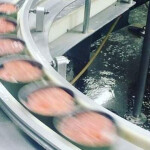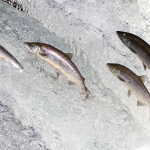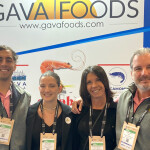Foreign-born immigrants are a small, but growing demographic in the U.S. state, of Maine, making up approximately 3.5 percent of its population, according to the Maine Multicultural Center.
While consumers in some countries from which New Mainers hail tend to eat more seafood than the average American, it wasn’t clear whether they were carrying those habits with them when they moved to seafood-rich state.
“[We] knew anecdotally that … a lot of other countries around the world eat a lot more seafood than the average American does and tend to also eat a broader diversity of fish and shellfish than we tend to here in the U.S., and we knew that we have this growing and increasing diversity of immigrant communities here in Maine as well,” Kyle Foley, who leads the Sustainable Seafood Program at the Gulf of Maine Research Institute (GMRI), told SeafoodSource.
GMRI and its partners – Maine-based supermarket chain Hannaford and the hunger relief organization Good Shepherd Food Bank – wanted more than anecdotal evidence or assumptions; They wanted to hear from immigrants on what their experience was with seafood and how they were engaging with local products.
“As our neighborhoods welcome more members from diverse backgrounds, we believe it’s our responsibility to ensure that our shopping experience and materials mirror the diversity of the customers who visit our stores,” Hannaford Seafood Category Manager Nathan Jewell told SeafoodSource. “We also have a strong commitment to supporting local products, including seafood from the Gulf of Maine.”
Last year, GMRI received a National Marine Sanctuary Foundation grant to fund a series of focus groups to gather input from New Mainers.
“They were really interested in expanding access to seafood for a broader diversity of communities and people [by] making sure that as the seafood industry thinks about building more demand that we’re doing it in an equitable way and being inclusive in how we build demand for seafood,” Foley said.
The trio of organizations decided to partner with Portland Adult Education, a local nonprofit that provides English as a second language classes, to recruit focus-group participants. There were 13 nationalities present in the focus groups, with about 75 percent coming from African countries.
Khadija Ahmed, a staff member at Good Shepherd Food Bank who immigrated to the U.S. from the Democratic Republic of the Congo approximately 20 years ago, facilitated the focus groups.
“[It] was really nice just to have an immigrant leader asking people the questions, and also, she’s a brilliant person who can speak several languages. Occasionally, when translation issues came up, she was often able to help out in the moment,” Foley said.
The focus groups largely confirmed the organizers’ suspicions. About 90 percent of participants said they’d prefer to eat more seafood than they currently do and that they’d eaten more seafood in their home countries, with some reporting they used to eat seafood every day of the week.
“There was definitely interest in eating local seafood, but [they just wanted] to understand more what the local suite of fish and shellfish looks like because that was not so familiar to a lot of folks,” Foley said. “We also heard that lack of familiar or preferred species in grocery stores where they were shopping as well as lack of whole fish is something that has been a barrier for some of these folks.”
The organizers had heard that concern before; Many immigrants were accustomed to buying whole fish rather than fillets. Participants wanted to see more whole fish at grocery stores, as well as other formats they were familiar with, like salted and dried fish.
“That’s potentially an opportunity for the local seafood industry to explore different formats for the species we do have here,” Foley said, while noting that it would take significant investment, since Maine producers don’t have the infrastructure in place to develop those products.
The organizations’ original plan to put out a series of recipes to help immigrants cook seafood was quickly put on the backburner as they found that participants were extremely confident in their own cooking and didn’t need assistance there. The real challenge, they said, was understanding what local species were available and how they might compare to the seafood with which they were familiar.
Instead, they began to work on seafood guidethat could be translated into the native languages of New Mainers and help them find locally available alternatives to the seafood they knew.
“In partnership with GMRI, we reflected on the results of the study and quickly realized there was an opportunity to educate immigrant communities who may not be familiar with local species and better connect them to our local seafood offerings at Hannaford,” Jewell said. “We believe this effort is dually beneficial – not only will it provide educational opportunities for new community members, but it will also help increase demand for local seafood at our stores.”
House of Languages, a translation service in Portland, Maine, then helped the group translate the guide into five languages: French, Arabic, Spanish, Portuguese, and Chinese. It is also available in English.
Foley said there “were not always completely direct, analogous species that we could compare everything locally to, especially because a lot of people we spoke to were coming from more tropical or warm-water parts of the world, where there’s just some inherent differences.”
“But, we tried to do our best to at least give people a sense of what it might be like to cook or what cooking methods might work well with local fish,” Foley said.
Hannaford also introduced a trifold brochure at its seafood counter, which has a QR code linking to the full PDF guides online, and Good Shepherd Food Bank distributed a similar brochure to food pantries the organization works with across the state.
“The brochure is currently available at the seafood counter in all 186 of our stores throughout New England and New York,” Jewell said. “A QR code brings customers to the fully translated guides available in six different languages. Within the brochure, customers will find information about our local seafood offerings, including flavor profiles, health attributes, cooking tips, and other attributes.”
Hannaford also began offering a unique internship program, the New Mainer Hannaford Retail Leadership Internship, for New Mainers in partnership with Portland Adult Education.
“[It] attracts and recruits foreign-born candidates with professional backgrounds to gain experience working in retail leadership,” Jewell said. “The 12-week paid internship offers both classroom and in-store training. Each student is paired with a Hannaford mentor to learn the operations of the store, as well as the complexities and dynamics of running a regional grocery store.”
Photo courtesy of Shutterstock / Earl D. Walker







